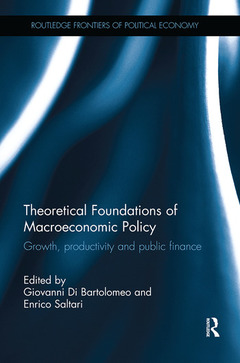Description
Theoretical Foundations of Macroeconomic Policy
Growth, productivity and public finance
Routledge Frontiers of Political Economy Series
Coordinators: Di Bartolomeo Giovanni, Saltari Enrico
Language: English
Subject for Theoretical Foundations of Macroeconomic Policy:
Keywords
Macroeconomics; Fiscal Policy; Money; Finance; Economics; Growth; Productivity; Labour Market; Inflation; GDP; Covariate Augmented Dickey Fuller; ICT Introduction; ICT Capital Stock; Empirical Correlation Matrix; International Monetary Fund; non-EU OECD Country; CES Production Function; UK Average; Gdp Growth; ICT Capital; Young Agents; Optimal Portfolios; Cd; Perfect Foresight Model; Foreign Currency Debt; Balance Sheet Constraints; Net Government Spending; Transaction Approach; Output Gap; British Pound; Random Matrix Theory; Steady State Real Interest Rate; Government Budget Constraints; Labor Income Tax; Potential Output
Publication date: 04-2018
· 15.6x23.4 cm · Paperback
Publication date: 07-2016
· 15.6x23.4 cm · Hardback
Description
/li>Contents
/li>Readership
/li>Biography
/li>
The recent economic events driven by the great financial crisis of 2007-08 has challenged some "dogma", highlighting various limits and drawbacks of current paradigms. The crisis showed the limitations of monetary policy and led to a revaluation of what levels of public debt can be considered safe. This volume aims to refresh the debate on some important long-run macroeconomic issues from new and fresh perspectives.
Theoretical Foundations of Macroeconomic Policy raises a number of questions relating to the challenges faced by macroeconomic theory and policies. The common line is the long run and policy perspective. The first part of the book is devoted to the theory of growth and productivity. The second part concentrates on long-run effects of fiscal and monetary policy. Specifically, topics investigated by the international range of authors are the theory of optimal growth, the productivity policies and production function estimations, demand- vs. supply- driven growth, optimal debt default and the incompleteness of financial markets, the long-run optimal inflation target and its relationship with public finance, the long term effects of government budget constraints on growth, and effect on optimal policies in non-market clearing environment.
The book will be of interest to postgraduates, researchers, and academics studying macroeconomics and fiscal policies.
Contents
Introduction
Part I –Theories
1 Optimal growth theory revisited
2 Continuous-time modelling
3 Demand factors and GDP growth
4 LAMP & banks balance sheet constraints
5 Secular Stagnation
Part II –Policies
6 Public finance and inflation
7 Government budget constraints
8 Productivity as an intermediate target
9 FX reserves for emerging economies
10 Labor market policies
Giovanni Di Bartolomeo teaches economic policy and monetary economics at the Sapienza University of Rome, Italy.
Enrico Saltari teaches economics and financial economics at the Sapienza University of Rome, Italy.




